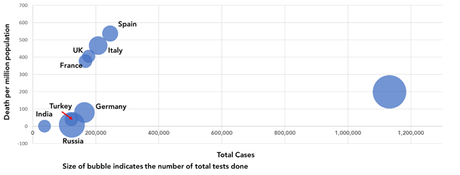Disclaimer: This post represents my personal opinion. This does not represent the opinion or policy position of my employer or any organization or agency or group that I am affiliated with.
The global spread of the COVID-19 pandemic has brought us face to face with new realities and unanticipated challenges. Globally, health systems have needed to adapt and change strategies as the changing epidemiology and emerging data has provided us with more intelligence about this viral contagion. The basic strategy to combat COVID-19 is simple: prevent the occurrence of new cases; detect new cases early and effectively, as soon as they appear; treat the cases to prevent occurrence of complications and death; and manage them through social distancing strategies to prevent the spread. One of the key components of this strategy is testing to identify the new cases. Given the novel nature of the pathogen, and the limited capacity to produce quality assured testing kits, this was a major challenge globally. In a country of 1.3 billion people, strategic optimization of the limited testing resources is essential to ensure equitable access. There has been accelerated scaling up of testing capacity in India, with a 70-fold increase in daily tests done in the last 40 days. Along with this exponential increment in testing in India, there has been a gradual widening of the ambit of testing beyond the high-risk groups, consistently conducting around 25 tests for every positive case detected over the same period.

India has entered a select group of countries, which have conducted over 1 million tests for COVID-19. When compared to the other nine countries, India has the lowest number of cases (39,980 as of 3rd May, 2020) and lowest population-based mortality (0.9 per million) from COVID-19. These numbers in themselves are remarkable, but given the complexities of scaling up a real time PCR based diagnostic test over a vast terrain such as India, it stands as a testimony to the political will, foreplanning and broad-based support required to achieve this.

The testing strategy has kept pace with the changing transmission dynamics of COVID-19. In the early stages of the epidemic in India, when transmission was limited to travelers coming from countries where there was already ongoing transmission of COVID-19, testing was limited to high risk travelers and was augmented with screening at ports of entry, in tandem with travel and visa restrictions for select high burden countries. As the infection began to spread, testing was also ramped up. Iterative calibration of the testing strategy, keeping pace with the evolving epidemiology of COVID-19, has enabled access to diagnostic testing for groups that need it most, ensured the prevention of wasteful or unnecessary testing and encouraged optimal scaling up of the testing infrastructure while other preventive public health interventions were being put in place.

Although testing is an important window into the evolution of COVID-19 in India, it is not a single-point panacea to help survive the pandemic. It is part of a larger package of interventions, and as such, needs to be recursively supportive of the other strategies. Multi-pronged approaches like physical distancing, bolstering health services infrastructure, and public health measures informed by optimal testing in sync with epidemic progression are necessary to beat COVID-19.
